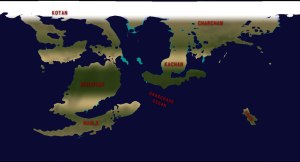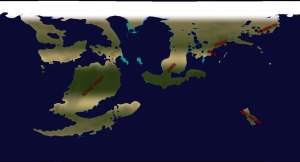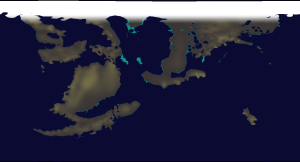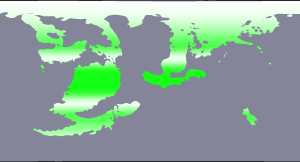The other day while testing tectonics.js in the background, I found a result I rather liked. I was intending to use tectonics.js to create the basic continental arrangement for my habitable planet orbiting 40 Eridani as part of an incredibly long project I’m working on. I found out in the process that the latest version of tectonics.js no longer works on my computer.
Apple stopped coming out with updates for Safari compatible with my computer at least one age ago, so apparently some of the newer features of javascript aren’t implemented. I have a fairly recent version of Firefox, but it hates my GPU. Chrome never ran tectonics.js on my computer, so that was right out. Thus, I had to dig through the git registry for rtectonics.js that worked on my computer and had the Texture projection feature. Took awhile, but I found a version that worked fine. To test the quality of its rendering, I set it on a very slow increment rate(theoretically about 0.005 MYr/sec). The slower the render speed, usually, the better the look of the render. I think I may have reached a point of diminishing returns:/.
The result I found, when I checked it in the morning was rather interesting. I don’t know if I will use it for the 40 Eridani project, but I am keeping it for later use.

The Satellite View shader of tectonics.js gives a good idea of the rough biome of regions. It’s sensitive to temperature, precipitation and altitude.
I did think I would show it off, here, though. I can go show the images I have generated, and go over the features that appealed to me particularly.
The first thing that I noticed about this map was that it vaguely reminded me of the map of Tschai from the Planet of Adventure books by Jack Vance.
You have to squint really hard to see the similarity. It also probably wouldn’t hurt to have a nut or two loose in your brain case like me!
Kotan is a bit soft pedaled. Kislovan and Haulk are a bit hulking. Charchan is kind of there(…). That island in the Draschade Ocean seems to have wandered a bit eastward, or maybe Vord fell to the south.
Okay. It’s not that close a resemblance, but it’s about as good as you could hope to come up at random.

The image marked up with approximations of features from Tschai. Some are more fanciful than others…
Anyway, with a similar exercise of the imagination, you could see bits of Earth in this map as well. This is a bit less literal than my effort with Tschai, although squinting and loose fasteners are similarly useful.
That island in the south east quadrant brings New Zealand to my mind. Isolated, temperate and perhaps a touch exotic. The temperate arc in the north east quarter looks like it could have an interesting Europe-like feel to it. Along the coast you go from the edge of a desert to something vaguely like Iberia. Further up the arch, you pass through regions similar to

If you thought Tschai was forced, take a gander at this attempt to place bits of an Earth map on the image.
France and perhaps Germany. Across a small gulf, you find Scandinavia or maybe a more continental Britain. Inland, to the north and west, you segue into possible steppelands, like Russia. If you head south to the upside-down tee-shaped peninsula, you find desert and tropical jungles like a diminutive Africa of sorts. This arrangement, with its pocket-sized tropical regions makes me think even more strongly of the World of Greyhawk. As you can see, the more specific we get, the more forced the comparisons become. This is all for the good. If we wanted to play on Earth, there are plenty of very good maps of that planet.
I would also want to add further points of oddness to the world as I detailed it. Strange flora and fauna. Unearthly environments. Earth itself has plenty of those, why shouldn’t this world?
Anyway, I thought this might be an interesting exercise in trying to visualize a world by looking at a fairly random map. “Fairly” random, because this is based on an attempt to model the tectonic processes that might be found in a real planet similar to Earth.
For added enjoyment. Hopefully. I’ve added some additional generated maps.

This is the “Bedrock” shader. For purposes of visualizing elevations, I think it gives a better feel for the variation in lower and flatter areas. Sadly, I wasn’t able to save an elevation map before Safari crashed on me. My computer makes me sad… LOL

This is the vegetation shader. It also gives a good idea of the ratio of evaporation to precipitation. Because insolation is an altogether positive effect in the algorithm used to generate this, that breaks down in the upper latitudes. One can figure on more snowfall in the upper reaches…
Comments and suggestions are always welcome. Criticisms might be appreciated…
Thank you for your attention.
The Astrographer

